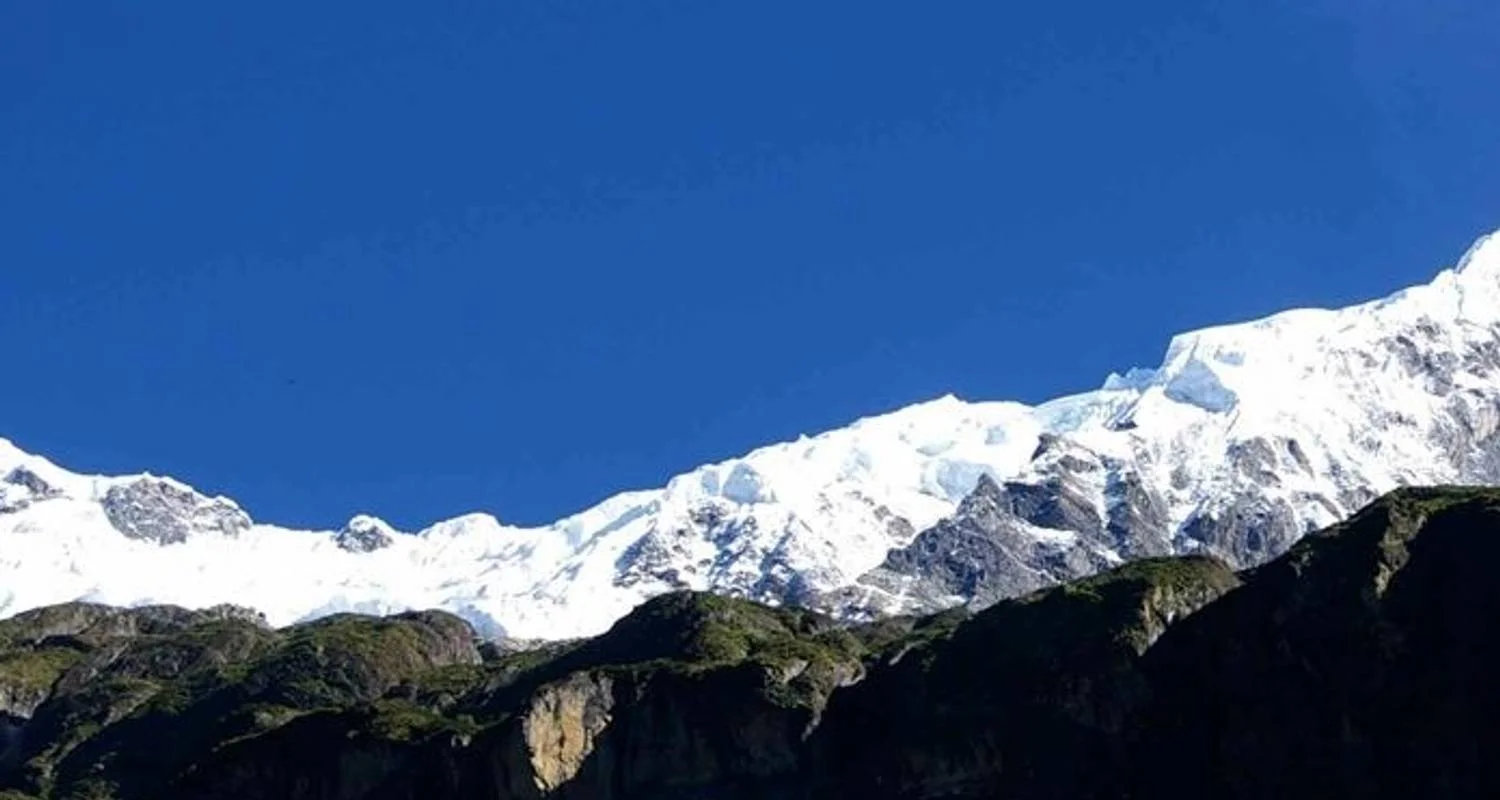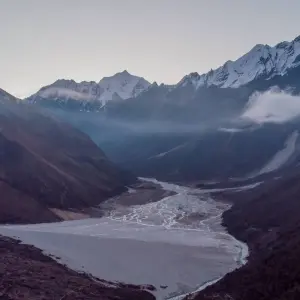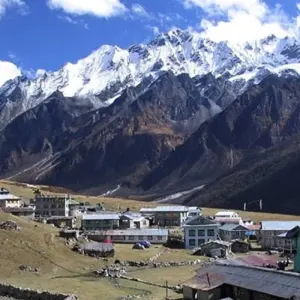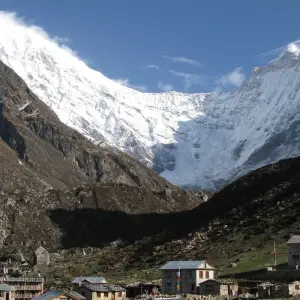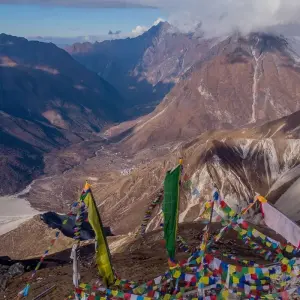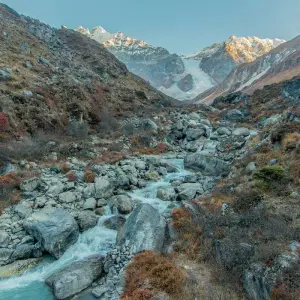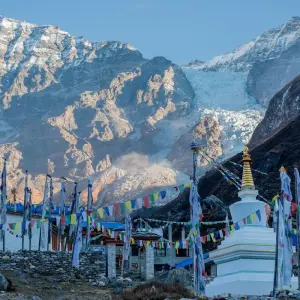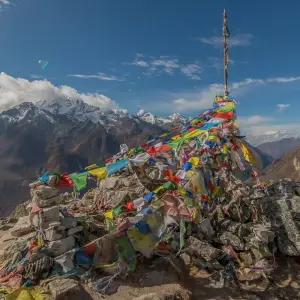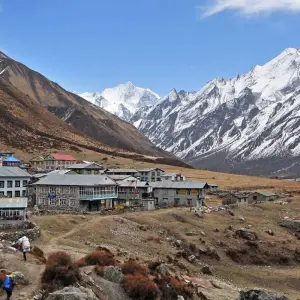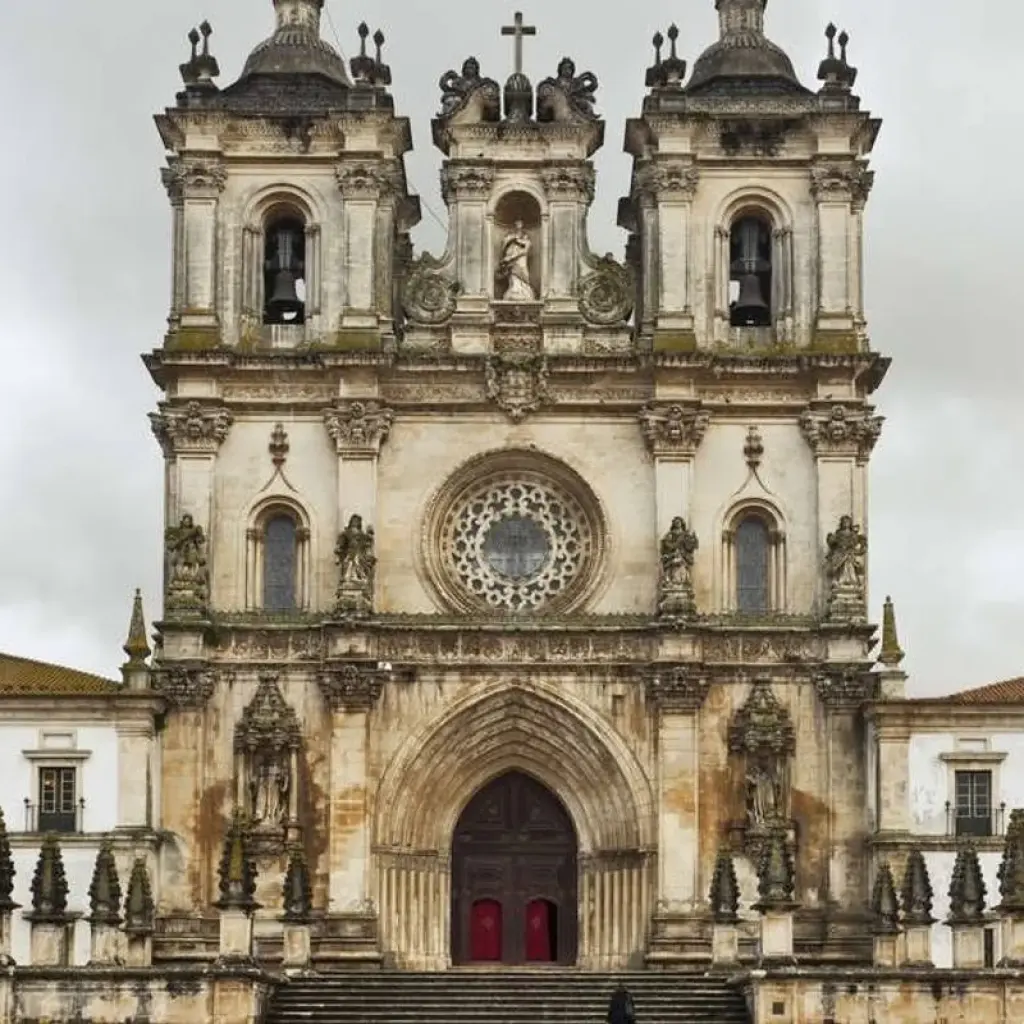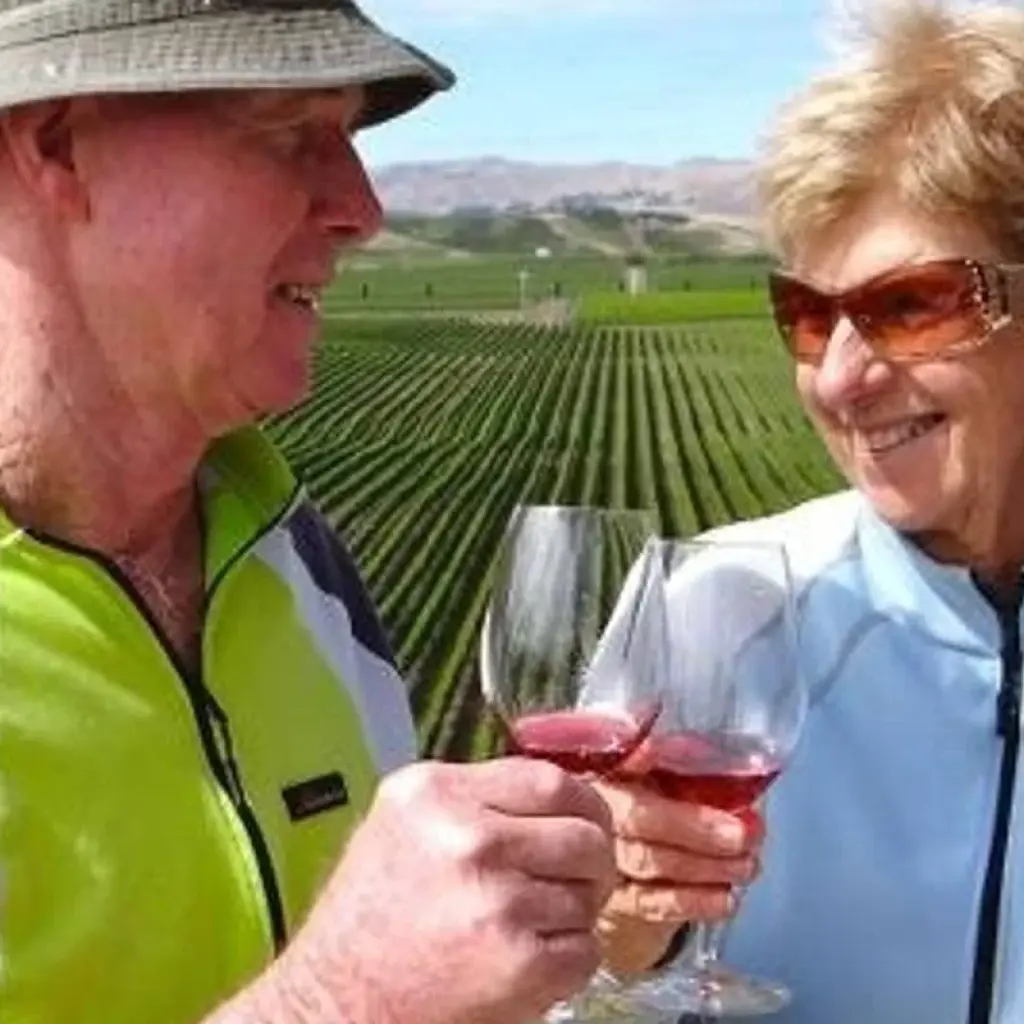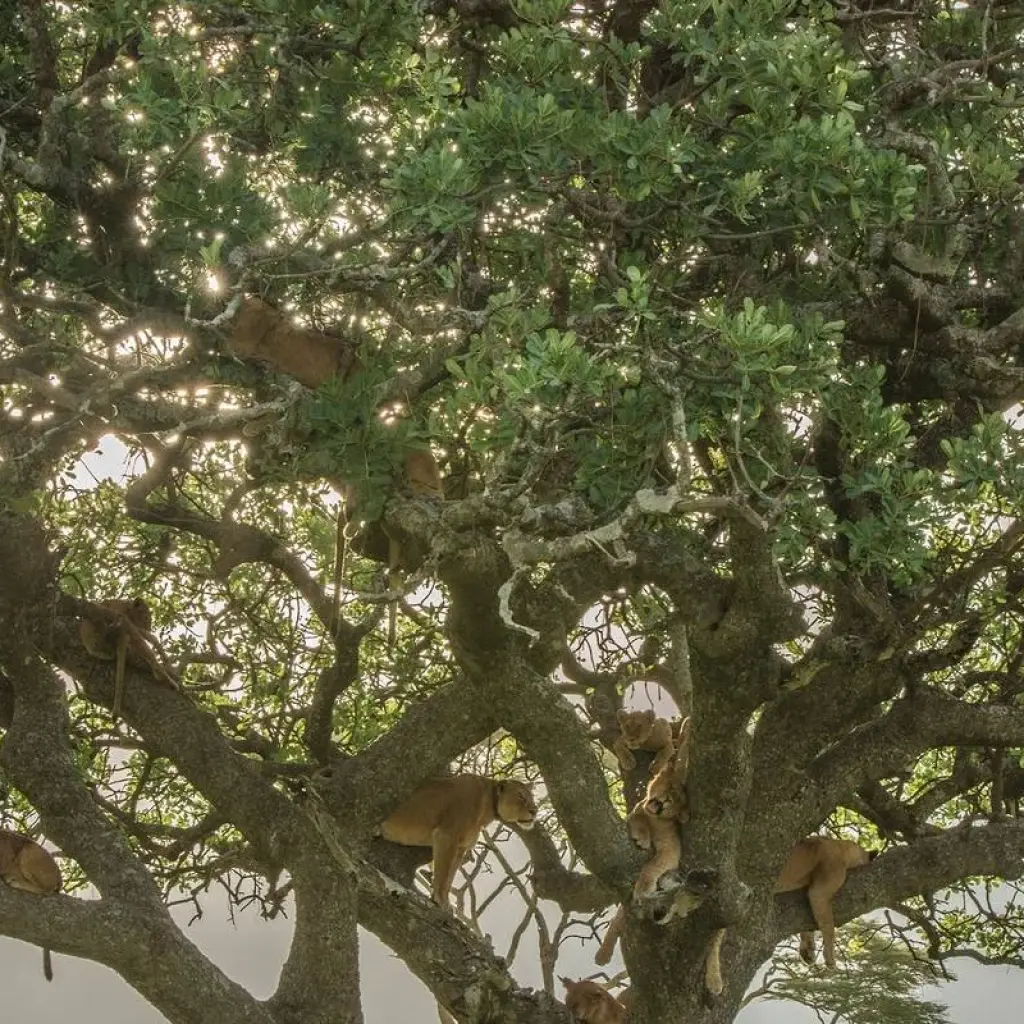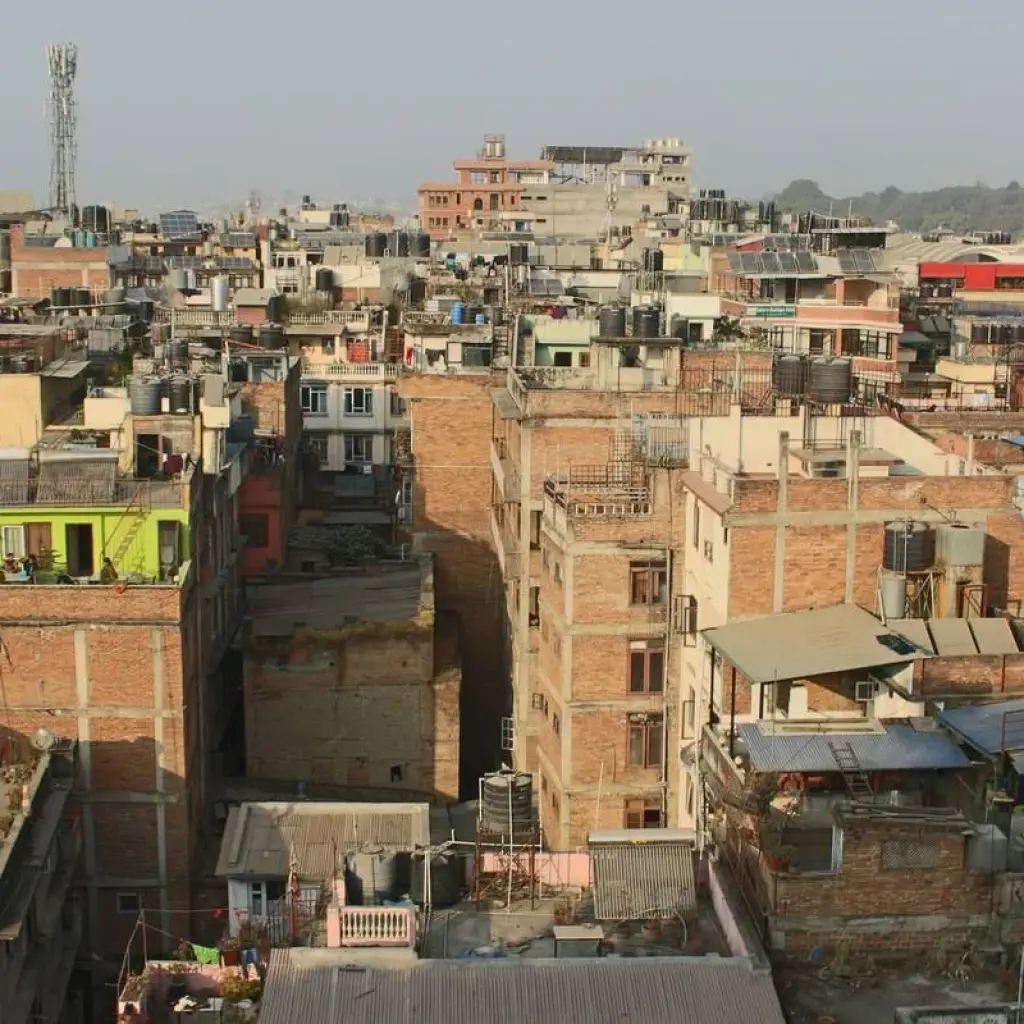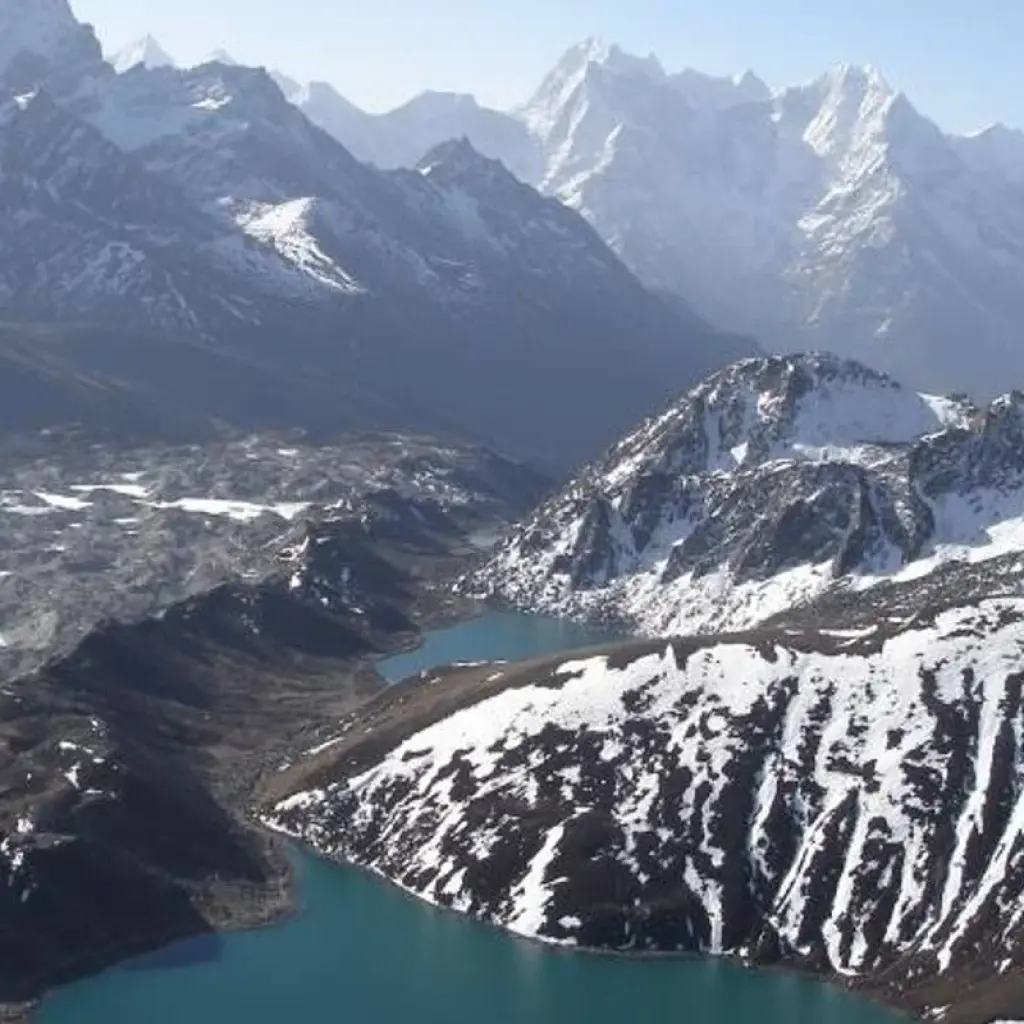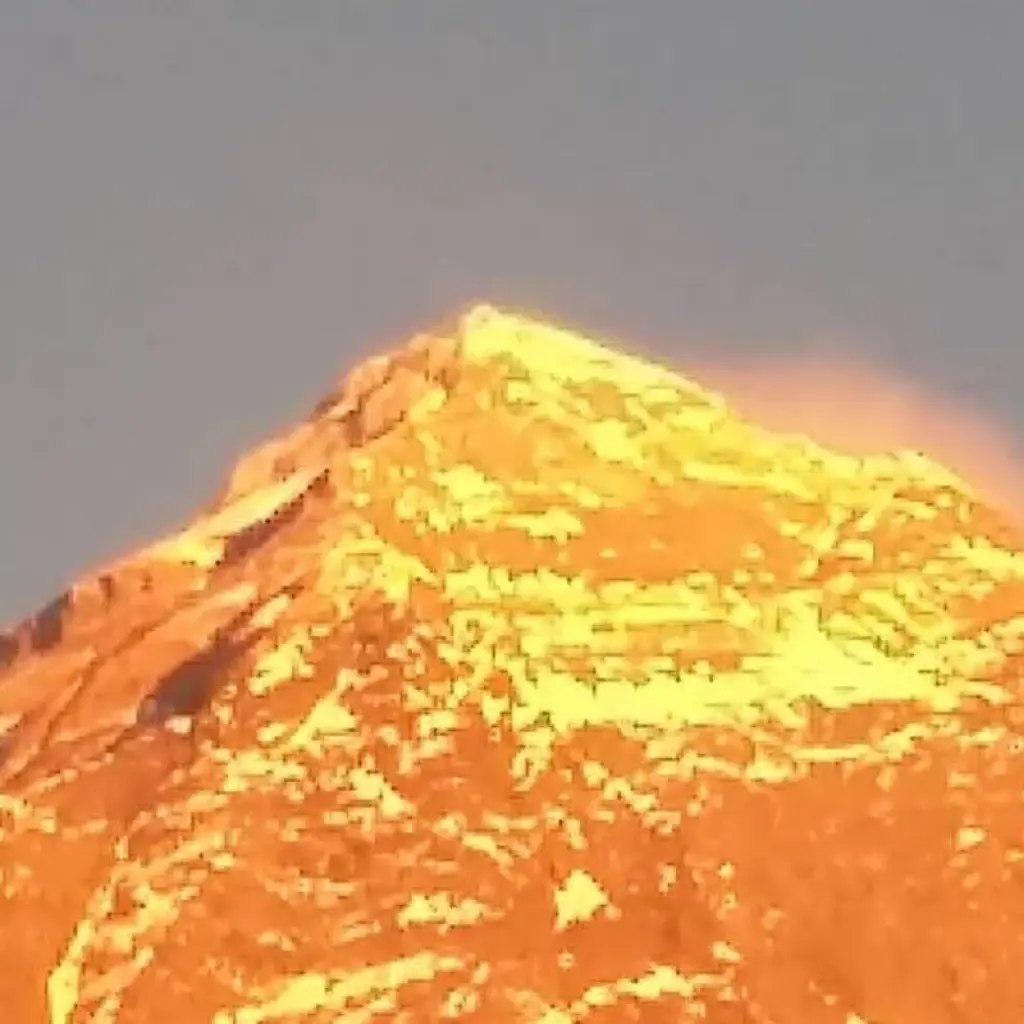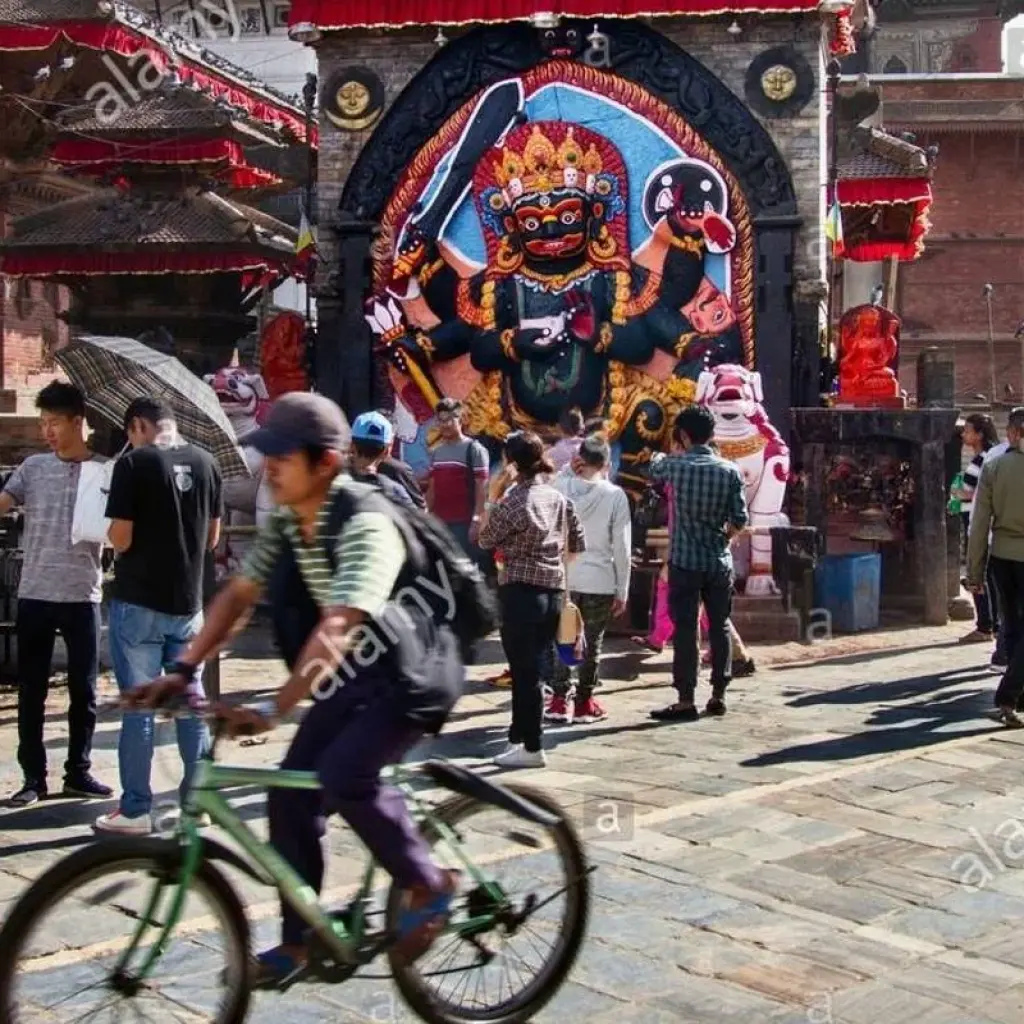Ihre Ankunft in Kathmandu erfolgt mit der Landung auf dem Tribhuvan International Airport (TIA). Ein Vertreter des Unternehmens Himalayan Adventure Treks & Tours wird Sie in Empfang nehmen und zu Ihrem Hotel bringen. Am Abend können Sie die Teilnehmer und die Mitglieder des Treks kennenlernen. Übernachtung in einem Hotel in Kathmandu.
Reiseroute
HIGHLIGHTS
- Einblicke in die tibetische und tamangische Kultur und Lebensweise.
- Besuchen Sie alte Klöster auf der Wanderung wie die Kyanjin Gompa.
- Genießen Sie die Aussicht auf die Langtang- und Jugal-Berge.
- Besteigen Sie den Kyanjin Ri (4773m) und genießen Sie die Aussicht auf das Langtang-Tal.
Übersicht
Der Langtang Valley Trek ist die nächstgelegene Trekkingroute von Kathmandu. Daher macht sich eine große Anzahl von Trekkern auf den Weg, um diese Region zu erkunden. Die tibetische und tamangische Kultur mit der Kulisse der Langtang-Bergkette bilden spannende Trekkingrouten. Auch die Flora und Fauna im Langtang-Nationalpark ist ziemlich surreal. Alles in allem ist der Trek eine herrliche Reise ins Langtang-Tal - das Tal der Gletscher.
Die 10-tägige Reise beginnt in Kathmandu, von wo aus Sie nach Syabrubesi fahren. Dann betreten Sie den Langtang-Nationalpark und fahren zum Lama Hotel. Der Trek führt nach Norden und erreicht Ghodatabela, was soviel wie Pferdestall bedeutet. Dann folgen Sie dem Pfad zum Dorf Langtang und lassen sich in der Kyanjin Gompa nieder. Das Kloster ist eines der ältesten im Langtang-Tal und bietet einen Einblick in die Geschichte und den Ursprung der gesamten Region selbst.
Im Durchschnitt müssen Sie 5-6 Stunden pro Tag wandern. Ebenso ist Syabrubesi mit 1.503 m der niedrigste Punkt auf der Wanderung und Kyanjin Ri (4.773 m) der höchste Punkt. Langtang Lirung (7227m), Yala Peak (5500m), Ganesh Himal (7422m) und die Jugal-Kette sind einige der Berge, die Sie auf dem Trekking genießen können. Außerdem leben tibetische und tamang-ethnische Gruppen entlang der Trekkingpfade auf dieser Reise.
Der Langtang Valley Trek kann von jedem aus jeder Altersgruppe gemacht werden. Es ist also keine vorherige Trekkingerfahrung erforderlich, aber Sie sollten in einer fitten Verfassung sein. Sie können einen Abstecher zum Gosainkunda-See oder zum Helambu-Tal machen, wenn Sie Interesse haben, mehr von dieser Region zu erkunden.
Bei Himalayan Adventure Treks & Tours bieten wir erschwingliche Reisepakete an, die Sie ganz nach Ihren Wünschen anpassen können. Wir haben auch die besten und erfahrensten Reiseleiter, die Sie auf Ihren Reisen begleiten. Außerdem garantieren wir Ihnen, dass Ihre Reise die beste ist, die Sie je erlebt haben und dass Sie immer wieder nach Nepal zurückkehren werden.
Ist Langtang Valley Trekking schwierig?
Langtang Valley Trekking ist ein moderater Trek im nördlichen Teil des Kathmandu-Tals und für jedes Niveau von Trekking-Enthusiasten geeignet. Es ist keine vorherige Trekkingerfahrung erforderlich, um diese Wanderung zu absolvieren. Die Trekking-Pfade sind größtenteils flach und entweder aufsteigend oder absteigend. Dennoch empfehlen wir Ihnen, Ausdauerübungen zur Vorbereitung auf den Trekkingweg zu machen.
Wenn Ihnen diese Wanderung zu extrem ist, können Sie auch mit dem Hubschrauber wandern, um die Schönheit des himmlischen Langtang-Tals aus der Luft zu genießen.
Grund, den Langtang Trek zu wählen?
Der Langtang-Tal-Trek ist eines der schönsten Alpentäler der Welt. Das Langtang-Tal ist eine der besten Optionen für eine kurze Wanderung und eine Kombination aus natürlichen Sehenswürdigkeiten nach ein paar Stunden Fahrt von Kathmandu. Der Langtang Trek beginnt in Syabrubesi, das 6-7 Stunden Fahrt von Kathmandu entfernt ist.
Panoramablick auf die Berge:
Das Langtang-Tal ist voll von der malerischen Aussicht auf das große Himalaya-Panorama der Berge wie Naya Kanga Peak (5846m), Langsisa Ri (6427m), Langtang Lirung (7227m), Dorje Lakpa (6966m), Langtang Ri (7205m), Dragmarpo Ri (6578m), Yala Peak (5520m) und viele mehr. Die Tamang-Kultur und ihre Lebensweise ist ebenfalls eine weitere Attraktion dieser Region.
Besteigung des Kyanjin Ri oder Tsergo Ri:
Der Kyanjin Ri oder Tsergo Ri ist der beste Aussichtspunkt im Langtang-Tal, von dem aus Sie den nächsten Blick auf den Changbu (6251m), den Langtang Lirung (7227m) und viele andere Gipfel haben und einen außergewöhnlichen Blick auf den Langtang Lirung Gletscher genießen können, nachdem Sie ein paar Stunden vom Kyanjin Gumba aus gewandert sind.
Gute Unterkunftsmöglichkeiten:
Das Langtang-Tal ist eines der beliebtesten Trekkingziele der Welt. Die Teehäuser/Lodges bieten den besten Service und heißen alle Gäste mit einem lächelnden Gesicht willkommen. Die meisten Gästehäuser/Lodges verfügen über zwei Betten, genügend Decken, Lademöglichkeiten für Geräte, Toiletten im westlichen Stil mit heißer und kalter Dusche, sind sauber und geräumig und bieten den Service des Nötigsten.
Besuch des Rhododendron-Waldes:
Rhododendron ist die Nationalblume Nepals. Grundsätzlich in der Frühlingszeit, d.h. zwischen dem Monat April und Mai. Sie können die schöne Aussicht auf blühende bunte Rhododendron im ganzen Dschungel genießen, die den Dschungel wie eine Braut aussehen lässt. Der Anblick der farbenfrohen Rhododendren vor dem Hintergrund der weißen Schneeberge ist wirklich sehenswert und eine unvergessliche Erfahrung fürs Leben.
Lokales Essen:
Das Essen in den Bergen ist immer biologisch und gesund. Bio-Lebensmittel über 2500 m gemacht so einzigartig und lecker. Gemüse von den lokalen Feldern können den Geschmack von Mundwasser und die herzliche Gastfreundschaft, großen Service fühlen Sie 100% zufrieden mit der Hilfe von Himalayan Adventure Treks & Tours.
Tourprogramm
Ankunft am Flughafen von Kathmandu.
Startpunkt
Tribhuvan International Airport (KTM) त्रिभुवन विमानस्थल, त्रिभुवन विमानस्थल, Kathmandu, Bagmati, Nepal
00:00 - 00:00
Fahrt von Kathmandu nach Shybru Besi (1503m) 6-7 Stunden. (Ü/L/D)
An diesem Tag fahren wir von Kathmandu aus mit dem Bus nach Syabru Besi. Die Straße ist voller aufregender Szenen und Ausblicke auf die mit Wäldern bedeckten Berge entlang des Trishuli-Flusses. Wir übernachten in einer Lodge in Syabru Besi. Am Abend können Sie die Umgebung erkunden.
Wanderung von Shybru Besi zum Lama Hotel (2500m) 6-7 Stunden. (B/L/D)
Nach dem Frühstück machen wir uns auf den Weg, um von Syabru Besi zum Lama Hotel zu wandern. Die Reise folgt dem in Tibet entspringenden Fluss Bhote Khosi und dem Langtang Khola. Der Weg windet sich hinauf, vorbei am Bamboo Village, das für seine Roten Pandas bekannt ist.
Wanderung vom Lama Hotel zum Langtang Tal (3430m) 5-6 Stunden. (B/L/D)
Heute steht uns ein weiterer Tag mit anstrengenden Wanderungen bevor, denn wir beginnen, ernsthaft den Berg hinaufzusteigen. Heute haben wir die Gelegenheit, die Ghoda Tabla, das Langtang-Dorf usw. zu erkunden.
Das Langtang-Dorf ist voll von flachen Unterkünften im tibetischen Stil, Getreidefeldern und Yak-Weideplätzen. Die herzhafte Bewegung wird mit einer fantastischen Landschaft belohnt, während wir durch Wälder mit rosa und weißen Rhododendren, Hemlocktannen und Eichen hoch über dem Langtang Khola wandern.
Wanderung vom Langtang-Tal nach Kyanjin Gompa ( 3835m) 3-4 Stunden. (B/L/D)
An diesem Tag wandern wir nach Kyanjin Gompa. Es ist eine kurze Wanderung von etwa 3-4 Stunden mit Blick auf die Berge und schneebedeckten Gipfel. Am Nachmittag können Sie die Yak-Käsefabrik besuchen. Die fantastischen Ausblicke auf die Naturlandschaft und die Berge sind beeindruckend.
Erkundungstag in Kyanjin Gompa & Wanderung zum Kyanjin Ri ( 4773m). (B/L/D)
Heute verweilen wir in der Kyanjin Gompa, denn heute ist unser Akklimatisierungstag. Er hilft uns, uns an die große Höhe zu gewöhnen. Wir werden einen kurzen Ausflug um die Kyanjin Gompa herum machen. Während des Ausflugs wandern wir zum Kyanjin Ri (hinter dem Dorf), der atemberaubende Panoramen auf die Langtang-Gipfel bietet.
Wanderung von Kaynjin Gompa zum Lama Hotel (2500m) 5-6 Stunden. (B/L/D)
An diesem Tag führt unser Trekking von Kyanjin Gompa zurück zum Lama Hotel. Die Ausblicke entlang des Weges sind beeindruckend, während wir zum Hotel zurückkehren. Wir übernachten im Lama Hotel. Sie können die Umgebung erkunden, wenn wir rechtzeitig vor dem Abend angekommen sind.
Wanderung vom Lama Hotel zum Sybru Besi (1503m) 5-6 Stunden. (B/L/D)
An diesem Tag wandern wir vom Lama Hotel zurück nach Syabrubesi. Der Weg ist derselbe, aber die Aufregung ist größer, wenn wir zum Zielort zurückkehren. Die Aussicht auf die Berge und die natürliche Vegetation entlang des Tals ist beeindruckend. Wir übernachten in Syabrubesi.
Fahrt von Shybru Besi nach Kathmandu mit dem Bus 6-7 Stunden. (B/L/D)
An diesem Tag fahren wir von Syabrubesi zurück nach Kathmandu. Nach einer 6-7-stündigen Fahrt erreichen wir Kathmandu. Sie werden zu Ihrem Hotel gebracht, wo Sie entweder Freizeit haben oder die letzten Momente nutzen können, um die verpassten Sehenswürdigkeiten zu erkunden oder Geschenke für Ihre Liebsten einzukaufen.
Am Abend gibt es ein Abschiedsessen in einem authentischen nepalesischen Restaurant mit einer kulturellen Darbietung.
Abreise zum Flughafen. (B)
Ein Vertreter von Himalayan Adventure Treks and Tours bringt Sie zum Flughafen, etwa 3 Stunden vor Ihrem geplanten Flug. Auf Ihrem Heimweg haben Sie genügend Zeit, um Ihr nächstes Abenteuer in dem wunderbaren Land Nepal zu planen.
Endpunkt
Tribhuvan International Airport (KTM) त्रिभुवन विमानस्थल, त्रिभुवन विमानस्थल, Kathmandu, Bagmati, Nepal
00:00 - 00:00
Details zur Tour
accommodation
- Two Night 3* hotel in Kathmandu with Breakfast.
- All accommodations in lodges/tea houses during the treks.
guide
- An experienced, helpful, and friendly Guide, porters (1 porter for 2 clients).
insurance
- Travel and rescue arrangement.
meals
- Lunch, Dinner, and Breakfast during trekking.
- Breakfast in Kathmandu.
optional
Equipment List for Langtang Valley Trek:
Langtang Valley Trek is moderate trekking but however our long-year experience of operating Trekking to Nepal, We learn many things and would like to give some information to pack your equipment list for your Trekking and we hope, this information will be helpful you so success your trip.
Luggage/Duffle bag:
You will require a duffel bag or a backpack for trekking (65- 75 L) max and all our trekking stuff are kept in this duffle bag and this will be carried by our porters. However, Himalayan Adventure also provides the duffle back if needed.
A day backpack:
You will need a day backpack and you will be carrying it every day by yourself and we recommend you it has to be at least 25L and you can carry important documents like Passport, credit card along with a need to carry a water bottle, snacks bar and clothing layers (hat, gloves, fleece, sunblock, poles, etc…).
Trekking/Hiking boots:
Langtang Valley is a moderate trek and It is very important to have good trekking boots and it should be waterproof (in case of snow, or rain) Make sure it should be fit on your feet and comfortable during walking. Also, recommend you bring the Crompton during the winter season in Nepal.
Sport Sandals:
You need to have a pair of sports shoes or sandals to use while you are in camp or tea houses after the trek.
Sneakers:
Langtang Valley Trek is moderate trekking so sneakers are not suitable for this trek so you can leave your sneakers in Kathmandu hotel until you get back.
Sleeping Bag:
You need to have a lightweight sleeping bag that works for the minus 15 degrees for the summer season but during the winter we recommend minus 20 degrees for the trekking. Himalayan Adventure can provide it if you need one but has to be returned after the trek.
Fleece jacket:
You need to have good quality fleece jacket at least 1 synthetic jacket or pullovers are a great alternative to fleece because they are lighter and more compressible and gives you enough warmth during the trekking.
Down jacket:
Down jacket is compulsory and recommends you to bring the warm enough so can keep you warm during the Trek.
Socks:
You need to have at least 5 pairs of thick socks during the spring & autumn but winter and monsoon need at list 7 pairs of socks for this trekking.
Lightweight/ warm insulated pants:
You need to have at least 3 pairs of lightweight trekking pants like Lightweight expedition thermal bottoms, Nylon hiking shorts, Softshell and hardshell trekking pants, Water/windproof trousers, and Casual pants so we can use as the weather.
Short-sleeved shirts:
You need to have 3 ice-breaker merino wool to keep you warm from the cold or synthetic shirts and if you are not allergic to wool products, merino wool is the ideal for Langtang Valley Trek. Himalayan Adventure also provides the 1 company T-shirt as a souvenir.
Long-sleeved shirts:
You need to have at least three shirts.
Underwear:
You need to have few pairs of underwear and this can be as much as you need as there are no washing facilities every day on Langtang Valley Trek so, we highly recommend you to have enough pair of underwear.
Waterproof jacket:
You need at least one waterproof jacket for the rain/snow and wind for the Langtang Valley Trek and waterproof pants may be on option.
Head and face gear:
Sun Hat or cap during the day time, Woolen Hat for morning & Evening and Polarized sunglasses are compulsory.
Hand gear:
You need warm gloves.
Traveling supplies:
Adapter Plug for Charging the Camera and Mobile, Camera belt, Passport belt ( nice to have), Swiss army knife (option), Flashlight, Headlamp, Water bottle, Extra camera battery, Hand sanitizer, Alarm clock, Hiking poles (optional ) and Binoculars (optional).
Toiletries:
Razor, razor blades, shaving cream, aftershave toothbrush, toothpaste, dental floss, sunscreen, toilet paper, small towel, and period pads (for women).
Medication:
First Aid Medical Kit box (can be purchased in Thamel Kathmandu), Altitude Medicines (Diamox), Tylenol, aspirin, ibuprofen, Anti-diarrheic, Powerful antibiotics, and Nasal Spray or Drops.
Physical Fitness:
Many people have questions as to what level of physical fitness is required for trekking in Nepal and that is extremely reliant on what activity the visitor is engaging in Nepal With that said, for a standard easy trek to Extreme hard level of trekking. The daily activity (trek) would be 5-6 hours,(depend on the trekking trail) and elevation will generally not exceed 5,600 meters like Everest Base Camp, Throng la passes, Chola passes treks and other passes or Base Camp but some of them are less than 4000m. The trekking day is involving both long steep climbs, and descents with a variety of terrain underfoot from well-trodden paths, to rocks covered with ice or snow, depending on the season. Mostly a day would include a number of climbs or descents of 600 meters more or less, starting after the early morning breakfast, resting at a lunch place in the afternoon, then continuous trekking until arriving at the teahouse.
In preparation for the trekking in Nepal, it is important, to begin with, the basic training requirement at least 2 months before departing for trekking in Nepal. Two to three hours of aerobic exercise like running, walking, swimming, cycling & some gym work per week is the minimum and most will find it beneficial to add some basic strength training to their physical fitness routine required for the hard trekking and for normal and easy trek just have some physical fitness is enough. One of the best ways to prepare is to take practice hikes with a daypack roughly the same weight as what you will be taking during the trek. Your calf should be enough fit and prepare for trekking. Mostly during the trekking calf paining or tired is the main issue. Do this only after a baseline of fitness has been reached. Moving fast is not our goal, will provide a more enjoyable and safe adventure trekking in Nepal for all easy and hard level.
Trekking Seasons in Nepal:
There are main two seasons in which Nepal where the most amount of visitors visit. (September, October & November) being the most popular season which is also called the peak season in Nepal, and spring (March, April & May) coming in close behind which is also called the mini-season in Nepal. The summer months of June, July, and August are the monsoon season and most of the time raining as such the trails are mostly washed out sometimes, and roads can sometimes be impassible due to landslide activates. Nevertheless, you can trek to rain-shadow regions like Upper Dolpo and Upper Mustang during the monsoon seasons. Nepal is a suitable destination for all seasons.
Winter is very dry & extremely cold and all the high passes become inaccessible due to ice and snow conditions. The temperature doesn’t usually fluctuate during the day time temperature is around 20-25 degrees. However, you gain the altitude the temperature decreases. The temperature can drop to around 0 to -25 degrees at night when staying at tented camps in Himalayan regions. Winter trek in higher altitudes is not advised due to the danger of avalanches and also altitude sickness. Although some may enjoy the sight of the snow-covered mountains as you reach your destination. However, the temperature does not change as much in lower mountain regions the nights are slightly colder than days’ time.
Autumn &Spring is the best timing for trekking in Nepal because the weather is generally warm and dry, and flowers are in bloom in the lower elevations of the country on the same time you can see the many festivals during that period.
Trekking Day:
A typical trekking day begins with the early morning breakfast around 7 am in the hotel. (Depend on the trekking region). It would advise you to pack your trekking gears in a duffle bag and essential supplies in your day pack after having breakfast; we begin the trek and head along the trail at around 8 am. The morning walk is more energetics to be longer as we begin with refreshed bodies and enthusiasm. A good morning’s walk, we make a stop for lunch at around 11-12 pm. The lunch involves group meals enjoying the vicinity around the stop & enjoys the organic & local food in the mountain. After resting for about an hour or two, we resume our trek to reach teahouse or camp by 2-3 pm. The afternoon walk is relatively shorter and can involve games and side trips as organized by the trekking experienced guides. You also can enjoy breaks during the trek to relax, read, and stroll around the area or doing yoga. You can explore with the local people and observe their lifestyle & culture. Dinner is served around 7-8 in the evening to round off the day.
Meals and Accommodations:
During the trekking period, the accommodation is commonly referred to as teahouses. These are family-run basic lodges that fill the role of the restaurant, Dining hall, and boarding house for tourists. Now a day’s electricity can be found in the rooms, which mean one light bulb, and one or two outlets for charging electronics. The common areas are also lit by electricity. Alternatively, teahouses may also use solar, hydroelectric, or have electrical lines running into the village, so the commonality and availability of electricity may vary. Still, a few of the trekking route electricity service is not available. Use the local traditional kerosene light.
Most of the teahouses have private rooms, though if the trek is in a more remote or high altitude place there are limited teahouses so season time dormitories are the norm. Most of the room has 2 single beds with basic bedding, and the bathroom is shared. Some of the places we can get the private bathroom also with a mix of western and squat style toilets in the bathrooms.
Breakfast and dinner are taken at the same teahouses and these lodges have large family style dining rooms centered on a stove or coal to provide heat basically in mountain areas. Most of the areas menu will have Nepali style western foods such as Pancake, pizza, Burger, fries, etc. Also on the menu is the traditional Nepali food Dal Bhat meal. This is a lentil soup with rice, vegetable, Pickle, or meat curry. Most menus will also offer a smattering of local cuisine.
Internal Flight Delays:
Nepal is an incredible and beautiful country of mixed of the White Mountains, deep valleys, Landscape, rivers, and green rolling hills. With this incredible diversity of landscapes, road travel can be extremely time consuming and flights within Nepal to reach popular trekking destinations is the easiest way. Not all the trekking destination has flight service, so road transportation is the only option. Mountainous terrain also comes with the possibility of in-climate weather. It mentions the incredibly high number of visitors during peak seasons makes internal flight delays a genuine possibility. To manage this situation, it may be helpful to have a few extras days on either end of your tour. If any cancellations or flight delays do occur (high chances of flight delays from around Kathmandu to Lukla, Everest region, Pokhara to Jomsom, Annapurna region), we also provide services to arrange chopper on the last stage to help you to be on your schedule on the premises of Civil Aviation Rules in Nepal which state that helicopters can fly if the visibility is 1500m. The cost ranges from USD400 to USD650 according to the number of passengers. The payment can be made either to the helicopter company or to us directly and can be made either by cash or using a credit card. It will be beneficial to purchase and review your insurance, the insurance companies may cover some of the alternative measures of travel. Flight insurance may cover changing your international flight if it is necessary.
Travel Insurance:
Most expeditions, Adventurous trekking, and tours require that travel insurance and it is purchased prior to arriving in Nepal, but other normal treks and tours may not require. However, travel insurance is definitely an important consideration. There are a number of reasons to consider insurance. Firstly, it may be required, so check to see what is being asked for by the company. Second, Nepal is a landlocked country, and there are only a few direct flights. Travel in and out from country can encounter some disruptions if purchasing insurance, make sure flight delays and cancellations also included. Always choose insurance that, though every safeguard is in place during your Holiday, there are always extenuating circumstances that may result in an accident during trekking & tours. Read carefully printout of insurance policies to ensure that the trekking or any other activity you are engaging in is covered or not, as some policies have stopped covering trekking in certain places. If you are going above 5000 m or high always mention the policies so it’s cover the chopper service in the last condition. It is very important that if you have the comfort of good insurance, so do the research and choose carefully which makes your trip relaxing and joyful.
Nepal Visa Entry Procedure:
There is only one International airport which is the Tribhuvan International Airport in Nepal. Immigration Office, TIA (Tribhuvan International Airport) under the Department of Immigration has been facilitating tourists flying to Nepal by providing Visa on Arrival.
‘On Arrival’ visa procedure is very quick and simple. October, November, March, April can expect some queues during peak Tourist season and October is basically the Nepalese got the Main festival Dashain. You can also get Visa from Nepalese Diplomatic Missions stationed abroad prior to your arrival. The choice is yours.
Visa obtains from Nepalese Diplomatic Missions, and then you must enter Nepal within six months from the visa issued date. Your total stay is counted starting from the day you enter into Nepal.
Visas obtained on Arrival at the Entry and Exit points are ‘Tourist Visas’. They bear multiple Re entry facility. Tourist Visa ‘On Arrival’ is the only entry visa to Nepal. If you are visiting Nepal for the purposes other than Tourism (sightseeing, tour, travel, mountaineering, trekking, visiting friends and families), you should still get ‘Tourist Visa’ to get into the country. However, you must change the category of visa as per your purpose and length of stay in Nepal from the Department of Immigration by producing required documents.
Please click below for the online Visa form.
http://online.nepalimmigration.gov.np/tourist-visa
The following visa rules apply for tourists:
For 15 days Multiple Entry Visa, the visa fee is the US $30 or equivalent foreign currency.
For 30 days Multiple Entry Visa, the visa fee is the US $ 40 or equivalent foreign currency.
For 100 days Multiple Entry Visa, the visa fee is the US $ 100 or equivalent foreign currency.
According to the immigration regulations, a tourist is allowed to stay in Nepal only for 150 days in a year. You can extend the visa up to another 90 days.
US$ 2 or equivalent Nepalese currency per day for extension.
Additional US$ 25 or equivalent Nepalese currency on visa fee, if Multiple Entry facility is required for the extended period
For more details please visit our FAQ link
https://www.himalayanadventuretreks.com/faq/
Acute Mountain Sickness (AMS):
Acute Mountain Sickness (AMS) is usually seen in un-acclimatized people shortly after ascent to high altitudes. The condition occurs due to the thinning of air as the altitude increases. The condition, if not taken seriously and treated immediately, can be life-threatening and its symptoms can be seen generally above 3200 meters. The symptoms of Acute Mountain Sickness are nausea, vomiting, tiredness, shortness of breath, and cerebral pain. The itineraries are designed to properly acclimatize you to the change in high altitude climate and sufficient precautionary measures too are taken to take utmost caution for our valuable guests. Our staff also equipped with cell phones and satellite phones (Option) in the occurrence of any emergency cases. We are greatly driven to keep the safety and security of our clients as our foremost concern.
Drinking-Water:
Water is essential for life, and clean water is imperative while on holiday. When visiting the less developed countries like Nepal it is a concern that all travelers should consider. There are few options when trekking or traveling in Nepal that will mitigate any chances of drinking contaminated water. The first consideration to take into account is that tap water should not be ingested. That even means when brushing your teeth in an urban area. Most will choose to buy bottled water and if doing so make sure the cap has sealed properly. Plastic bottle reuse is a big problem, and with that being said there are other options on the market to assist in making water drinkable. Mountain spring water is drinkable but if you use the purified tablet. The conservation area project also sells this tablet most of the trekking area. A guide will assist you to find out it also.
Arrival Instruction:
Upon your arrival at Tribhuvan International Airport (TIA) Kathmandu Nepal, our company representatives are stationed to welcome you to the country. We request you to carefully look for your and company name placard being held by our representatives following the events upon landing. Our representatives will be responsible to escort you up to your hotel in Kathmandu. There are many brokers, Taxi drivers, and trouble maker people offering you to carry your luggage and take you to your destination as you exit from the gate. We request you to pay no attention to these people and follow the company representatives and follow their instructions.
How to Book Your Tour:
Before booking any tour or trekking please read all the terms and conditions thoroughly and call or email the company representative with any questions prior to making any payments. Begin by filling out a booking form and pay the non-refundable deposit. Fill out the form completely and if any confusion contacts the company person so as not to disrupt the expediency of the process. The form may be submitted online or by downloading the form and mailing or Whatsapp the form to your company representative.
It is very important to understand all aspects of the chosen trip, from what’s included and excluded, to the level of service, or even what trip may be right for your level of experience and fitness. Take the time to get all the questions answered so that when booking the trip, it is without trepidation.
others
- Nepal Visagebühr, die Sie leicht am Flughafen von Kathmandu erhalten können.
- Internationale Flugkosten nach und von Kathmandu.
- Reise- und Rettungsversicherung.
- Persönliche Ausgaben (Telefongespräche, Wäsche, Barrechnungen, Aufladen der Batterien, zusätzliche Träger, Flaschen- oder abgekochtes Wasser, Duschen usw.).
- Pick up from Airport and Transfer to the hotel.
- Two Night 3* hotel in Kathmandu with Breakfast.
- Kathmandu/Syabrubesi/Kathmandu by bus.
- Lunch dinner and breakfast during trekking.
- All accommodations in tea houses during the treks.
- National Park Permit.
- All necessary paper works.
- ‘Trekkers’ Information Management System (TIMS) Permit.
- An experienced, helpful, and friendly Guide, porters (1 porter for 2 clients).
- Medical supplies (first aid kit will be available).
- All government taxes.
- Last night farewell dinner at an authentic Nepalese restaurant with a cultural performance.
transport
- Abholung vom Flughafen und Transfer zum Hotel.
- Kathmandu/Syabrubesi/Kathmandu mit dem Bus. (kann auf den privaten Jeep upgraden)
Gut zu wissen
Währung
Nepalese Rupee
Nepal

